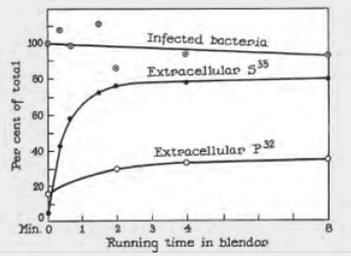
Concept explainers
Hershey–Chase Experiments The graph shown in FIGURE 8.5 is reproduced from an original 1952 publication by Hershey and Chase. Bacteriophage were labeled with radioactive tracers and allowed 10 infect bacteria. The virus–bacteria mixtures were then whirled in a blender to dislodge any viral components attached to the exterior of the bacteria. Afterward, radioactivity from the tracers was measured.

FIGURE 8.5 Detail of Alfred Hershey and Martha Chase’s 1952 publication describing their experiments with bacteriophage.
“Infected bacteria” refers to the percentage of bacteria that survived the blender.
Before blending what percentage of each isotope. 35S and 32P, was extracellular (outside the bacteria)?
To explain: The percentages of
Concept introduction: DNA is the organic molecule that carries information from one generation to another. Several experiments were to be conducted to prove that DNA is the genetic material. One such experiment is the Hershey–Chase experiment commonly known as the blender experiment. Bacteriophages are viruses that infect the bacteria and take up their translation machinery for their life cycle. This property was exploited to prove that DNA is a genetic material along with the help of radioactive isotopes.
Explanation of Solution
A graph was plotted with running time in the blender as X-axis and percentage of radioisotopes and infected bacteria in the Y-axis. Three scatter plots were drawn one for each radioactive tracer
Before blending the mixture that is, at 0 minute the percentage of radioactive tracers were measured. The percentages of
Want to see more full solutions like this?
Chapter 8 Solutions
Biology: The Unity and Diversity of Life (MindTap Course List)
Additional Science Textbook Solutions
SEELEY'S ANATOMY+PHYSIOLOGY
Microbiology Fundamentals: A Clinical Approach
Human Physiology: An Integrated Approach (8th Edition)
Physics for Scientists and Engineers: A Strategic Approach, Vol. 1 (Chs 1-21) (4th Edition)
Organic Chemistry
- a. What percentage of a drug is eliminated after 4 half-lives? Please round to the nearest percent. b. What will happen to elimination of the drug in the previous question if the system is saturated? explain and show any math involvedarrow_forwardIf you wanted to reduce the difference between peak and trough levels that occur with repeated administration of a drug, how would you adjust the dose and dose interval without changing the plateau concentration (plateau is the average of peak and trough levels)? Select your answers for both dose and interval. Hint: It may be helpful to think about this problem using an example such as food. How would you eat if you wanted to maintain very steady hunger/satiety levels without changing your total caloric intake? Options: A. Dose; Increase dose B. Dose; Decrease dose C. Dose; Do not change dose D. Interval; Increase the interval between doses (give the drug less frequently) E. Interval; Decrease the interval between doses (give the drug more frequently) F. Interval; Do not change the intervalarrow_forwardWhat percentage of a drug is eliminated after 4 half-lives? Please round to the nearest percent. Show the matharrow_forward
- Briefly explain the 6 domain of interprofessional collaboration: Role clarification, Team functioning, Interprofessional communication, Patient/client/family/community-centered care, Interprofessional conflict resolution, Collaborative leadership. Provide a specific negative events that nursing student would observe in a clinical setting for each domain.arrow_forwardwhat is an intermittent water course and what kind of fish habitat it would providearrow_forwardwhy are native freshwater mussels are an important part of great lakes ecosystemarrow_forward
- what morphological features differentiate the lamprey species and other species in the great lakesarrow_forwardThere are a wide range of therapeutic applications available as options for patients. Medical professionals should be aware of these applications so they can make informed recommendations to patients. To gain a better understanding of some therapeutic applications and how they are related to RNA and mRNA, research long non-coding RNA. Respond to the following in a minimum of 175 words: What is lncRNA and what does it do? How does IncRNA differ from mRNA? What are some therapeutic applications associated with lncRNA? Think about possible future uses of this application. What are the advantages and disadvantages of this application and its continued use?arrow_forwardfour fish or mussel species that are native to the great lakesarrow_forward
- There are a wide range of therapeutic applications available as options for patients. Medical professionals should be aware of these applications so they can make informed recommendations to patients. To gain a better understanding of some therapeutic applications and how they are related to RNA and mRNA, research long non-coding RNA. Respond to the following in a minimum of 175 words: What is lncRNA and what does it do? How does IncRNA differ from mRNA? What are some therapeutic applications associated with lncRNA? Think about possible future uses of this application. What are the advantages and disadvantages of this application and its continued use?arrow_forwardfour physial characteristics of a fish or a mussel that would help you identify it to a speciesarrow_forwarddescribe what you would do in this situation, you are working ona. river and it will take 20 minutes by boat to get back to the field truck, you are 1 hour from finishing the field work on the last day of field trip. you hear thunder int he dsitnace, what did you do?arrow_forward
 Biology: The Unity and Diversity of Life (MindTap...BiologyISBN:9781305073951Author:Cecie Starr, Ralph Taggart, Christine Evers, Lisa StarrPublisher:Cengage Learning
Biology: The Unity and Diversity of Life (MindTap...BiologyISBN:9781305073951Author:Cecie Starr, Ralph Taggart, Christine Evers, Lisa StarrPublisher:Cengage Learning Biology 2eBiologyISBN:9781947172517Author:Matthew Douglas, Jung Choi, Mary Ann ClarkPublisher:OpenStax
Biology 2eBiologyISBN:9781947172517Author:Matthew Douglas, Jung Choi, Mary Ann ClarkPublisher:OpenStax Human Heredity: Principles and Issues (MindTap Co...BiologyISBN:9781305251052Author:Michael CummingsPublisher:Cengage Learning
Human Heredity: Principles and Issues (MindTap Co...BiologyISBN:9781305251052Author:Michael CummingsPublisher:Cengage Learning- Essentials of Pharmacology for Health ProfessionsNursingISBN:9781305441620Author:WOODROWPublisher:Cengage





